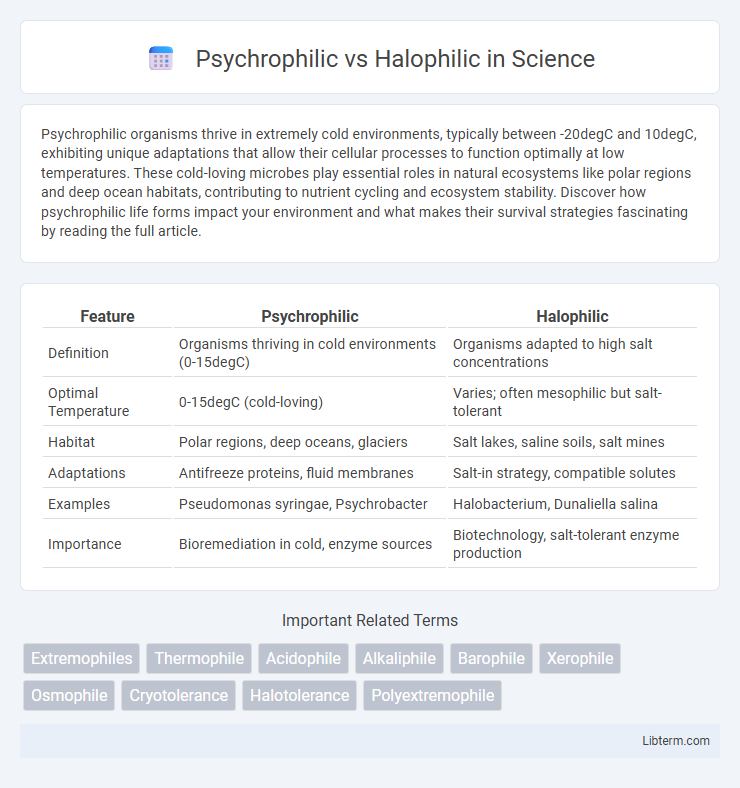Psychrophilic organisms thrive in extremely cold environments, typically between -20degC and 10degC, exhibiting unique adaptations that allow their cellular processes to function optimally at low temperatures. These cold-loving microbes play essential roles in natural ecosystems like polar regions and deep ocean habitats, contributing to nutrient cycling and ecosystem stability. Discover how psychrophilic life forms impact your environment and what makes their survival strategies fascinating by reading the full article.
Table of Comparison
| Feature | Psychrophilic | Halophilic |
|---|---|---|
| Definition | Organisms thriving in cold environments (0-15degC) | Organisms adapted to high salt concentrations |
| Optimal Temperature | 0-15degC (cold-loving) | Varies; often mesophilic but salt-tolerant |
| Habitat | Polar regions, deep oceans, glaciers | Salt lakes, saline soils, salt mines |
| Adaptations | Antifreeze proteins, fluid membranes | Salt-in strategy, compatible solutes |
| Examples | Pseudomonas syringae, Psychrobacter | Halobacterium, Dunaliella salina |
| Importance | Bioremediation in cold, enzyme sources | Biotechnology, salt-tolerant enzyme production |
Introduction to Psychrophilic and Halophilic Microorganisms
Psychrophilic microorganisms thrive in cold environments, typically at temperatures below 15degC, while halophilic microorganisms are adapted to high-salt environments, often requiring salt concentrations above 3%. Psychrophiles possess specialized enzymes and membrane structures that enable metabolic activity at subzero temperatures, making them crucial in polar ecosystems and biotechnological applications involving cold processes. Halophiles utilize unique osmoprotectants and ion pumps to maintain cellular integrity in hypersaline habitats such as salt lakes and salt mines, contributing to nutrient cycling in extreme saline environments.
Defining Psychrophiles: Life in the Cold
Psychrophiles are microorganisms that thrive in extremely cold environments, typically at temperatures below 15degC, with optimal growth around 0-10degC. Unlike halophiles, which require high salt concentrations for survival, psychrophiles adapt through specialized enzymes and membrane structures that maintain cellular function in freezing conditions. These adaptations enable psychrophilic organisms to inhabit polar regions, deep ocean waters, and alpine environments where low temperatures dominate.
Understanding Halophiles: Survival in High Salt Environments
Halophilic microorganisms thrive in environments with salt concentrations often exceeding 20%, utilizing specialized protein structures and ion pumps to maintain osmotic balance and prevent dehydration. These extremophiles produce compatible solutes like ectoine and betaine to protect cellular machinery from salt-induced denaturation. Understanding halophiles provides insights into biotechnological applications such as bioremediation of saline habitats and development of salt-tolerant enzymes for industrial processes.
Unique Adaptations of Psychrophiles
Psychrophiles exhibit unique adaptations such as flexible enzymes and cell membranes rich in unsaturated fatty acids, enabling functionality at subzero temperatures. These microorganisms produce antifreeze proteins to inhibit ice crystal formation, ensuring cellular integrity in cold environments. Unlike halophiles, psychrophiles do not require high salt concentrations but thrive in extreme cold, reflecting specialized genetic and metabolic traits for cold adaptation.
Specialized Mechanisms of Halophiles
Halophiles employ specialized mechanisms such as potassium ion accumulation to counteract osmotic stress in hypersaline environments, ensuring cellular stability. Their proteins and enzymes exhibit structural adaptations, including increased acidic amino acids that enhance solubility and functionality under high salt concentrations. These unique molecular strategies enable halophilic organisms to maintain metabolic activities and cellular integrity where psychrophiles rely primarily on cold-adaptive protein flexibility and membrane fluidity for survival in low-temperature conditions.
Environmental Niches: Where Psychrophiles and Halophiles Thrive
Psychrophiles thrive in extremely cold environments such as polar ice caps, deep ocean waters, and high-altitude regions where temperatures often remain below 15degC. Halophiles inhabit hypersaline environments including salt flats, salt mines, and saltwater lakes with salinity levels exceeding 20%. Both extremophiles adapt to their unique niches, optimizing cellular processes to survive in extreme cold or high salt concentrations, respectively.
Industrial and Biotechnological Applications
Psychrophilic microorganisms thrive in cold environments and are utilized in industrial processes such as cold-water detergents and bioremediation in polar regions due to their production of cold-active enzymes. Halophilic organisms, adapted to high-salt conditions, are exploited for biotechnological applications including the production of stable enzymes for saline industrial processes and bioplastics synthesis in hypersaline environments. Both psychrophilic and halophilic microbes offer unique biochemical pathways for sustainable industrial biotechnology, leveraging extreme environmental adaptations for enhanced process efficiency.
Challenges and Limitations in Studying Extremophiles
Studying psychrophilic and halophilic extremophiles encounters challenges due to their adaptation to harsh environments, such as subzero temperatures for psychrophiles and high salt concentrations for halophiles, which complicate laboratory replication. Limited growth rates and the requirement for specialized equipment to simulate extreme cold and hypersaline conditions restrict experimental studies. Genomic and proteomic analyses are often constrained by difficulties in isolating and culturing these microorganisms, hindering comprehensive understanding of their metabolic pathways and stress-response mechanisms.
Evolutionary Insights from Psychrophilic and Halophilic Organisms
Psychrophilic and halophilic organisms exhibit distinct evolutionary adaptations that enable survival in extreme cold and high-salinity environments, respectively. Psychrophiles have evolved specialized enzymes with increased flexibility and membrane lipids that maintain fluidity at low temperatures, while halophiles have developed high intracellular salt concentrations and unique osmoprotectants to prevent dehydration and maintain cellular function. Comparative genomic analyses reveal convergent evolutionary strategies, such as the expansion of gene families related to stress response and environmental sensing, highlighting the molecular basis of extremophile resilience.
Future Prospects and Research Directions
Research into psychrophilic and halophilic microorganisms is advancing toward biotechnological applications in extreme environments and sustainable industrial processes. Future prospects emphasize genomic and proteomic analyses to uncover adaptive mechanisms for cold and high-salinity conditions, enabling innovations in bioremediation, pharmaceuticals, and bioenergy. Emerging studies aim to engineer enzyme stability and metabolic pathways, expanding the uses of extremophiles in synthetic biology and environmental resilience strategies.
Psychrophilic Infographic

 libterm.com
libterm.com